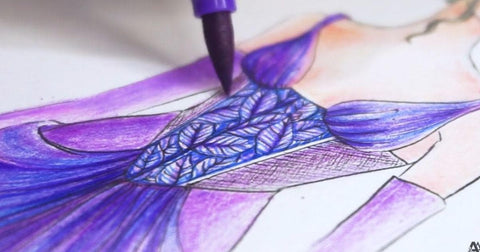How to Create Better Depth and Perspective in Paintings
Last Updated: October 13, 2025
"Painting is an illusion, a piece of magic, so what you see is not what you see." – Philip Guston.
Have you ever looked at an artwork and felt like you were actually there? From their beautiful colors to their realistic depiction of light, some paintings are created to take our eyes to where the artist was. Want to know their secret? Perspective!

In the realm of paintings, mastering the art of creating depth and perspective is like opening a gateway to a new world of mesmerizing artwork. For this blog post, we'll delve into essential techniques, tricks, and insights to elevate your paintings with perspective, depth, and composition. So let's go and transform your work from ordinary to extraordinary!
What Is Depth and Perspective in Art?
Depth and perspective are fundamental concepts that give two-dimensional artworks, such as watercolor and gouache paintings, the illusion of three-dimensional space and depth. They play a crucial role in creating a sense of realism and engaging the viewer's eye, making the artwork appear more lifelike and immersive.

Think about it: When you view rolling fields, for example, you do not see objects in equal lengths, shapes, colors, and sizes. It might be that you see mountains behind each other or that some mountains appear more prominent and darker to you than others. Our world is a 3D world, and if you want your art to have a sense of realism, your paintings should incorporate that trait too.
When tackling depth and perspective in art, depth refers to the perceived distance between different elements in a painting. On the other hand, perspective is the technique used to represent this depth on a flat surface, such as your canvas or watercolor paper. Most artists use various methods like foreshortening, vanishing points, and atmospheric perspective to manipulate the size, position, and clarity of objects to create a sense of distance and space.
By understanding and skillfully applying these principles in art, you can breathe life into your compositions, making them more visually captivating and emotionally compelling.
The Different Kinds of Perspective Techniques in Art
In the world of art, many perspective techniques will allow you to create the illusion of depth and three-dimensionality. Here are some of the most common types of perspective techniques:
Linear Perspective
This is the most traditional form of perspective, where parallel lines appear to converge at a vanishing point on the horizon line. It helps artists depict objects and scenes with depth and distance.
One-Point Perspective
This is a subset of linear perspective, where all lines converge to a single vanishing point. It's often used for depicting scenes with a strong sense of depth, like a road or railway disappearing into the distance.
Two-Point Perspective
In this technique, two vanishing points are used, typically employed when the subject is viewed at an angle. It's commonly used for buildings and architectural drawings.
Three-Point Perspective
Here, three vanishing points are used, usually employed when looking up or down at a subject, such as a tall building or a deep canyon.
Curvilinear Perspective
Unlike linear perspective, this technique applies to scenes with curved or cylindrical objects, where the lines bend around the surface of the objects.
Aerial Perspective (Atmospheric Perspective)
This technique involves creating a sense of distance by making objects in the background lighter, less detailed, and more muted in color, while the foreground objects are more vibrant and detailed. You can see this technique often in landscape paintings.
Isometric Perspective
Often used in technical and architectural drawings, this technique represents objects with parallel lines that remain parallel and do not converge.
Fish-Eye Perspective
This technique involves a unique and distorted perspective that creates a circular and wide-angle view of the scene, simulating the effect of a fish-eye lens. It is perfect for abstract or surrealist art.
Each perspective technique is a powerful tool allowing you to manipulate space, depth, and realism. We recommend practicing one project idea per technique so that when you apply these techniques to your grand masterpiece, it will be easier!
Tips and Tricks for Creating Depth in Your Artwork

Artists' Watercolor 24 Pan Set
Besides using the perspective techniques mentioned above, you can also use other elements to create one-of-a-kind visual experiences in your art. If you need a detailed guide on creating depth, take a look at some of these tips:
- Use Overlapping: Overlapping objects create a sense of depth as they suggest one object is positioned in front of another. It adds a three-dimensional quality to your composition.
- Size Variation: Subjects that are farther away should appear smaller, while closer subjects should be larger. This size variation reinforces the illusion of depth.
- Placement on the Picture Plane: Position objects closer to the horizon line for a distant appearance and move them lower on the canvas for a closer look.
- Atmospheric Perspective: Employ atmospheric perspective by making distant objects lighter in color, less detailed, and blurrier while adding more detail and contrast to foreground objects.

Watercolor Paper Set (A2 loose sheets)
- Contrast and Value: Enhance depth by using darker values and higher contrast in the foreground and lighter values with lower contrast in the background.
- Detailing: Add intricate details to objects in the foreground and gradually reduce the level of detail as you move toward the background.
- Foreground Elements: Incorporate elements in the foreground, such as branches, leaves, or rocks, to frame the scene and create a sense of depth.
- Blur and Focus: Use selective focus or blur to emphasize the main subject and blur out less essential elements in the background.
- Texture and Layering: Experiment with different textures and layering techniques to give depth and tactile quality to your artwork.
- Use a Reference: If you're uncertain about the perspective of your subject, use reference images or study photographs to understand how objects appear at different distances.
- Study Master Artists: Analyze the works of renowned artists who excel in creating depth, and learn from their techniques and approaches.
- Experiment and Practice: This is the most important rule - don't be afraid to experiment! Try various techniques and styles. Regular practice will enhance your understanding of depth and improve your artwork over time!
Create Museum-Worthy Artwork With This Handy Guide!
Now that you know how to create depth in a painting, it's time to pick up your brushes and start! We hope that this blog post has given you the confidence to experiment with depth in art. Remember, it's not just about technical precision but also about infusing your unique artistic vision into every brushstroke.
So, go forth with newfound knowledge, explore the infinite possibilities, and continue to paint a vibrant and compelling reality of your own making. For more inspiration on how to draw the illusion of depth, check out some of the beautiful works on our Meet the Artist Behind the Art interviews. Happy painting!






